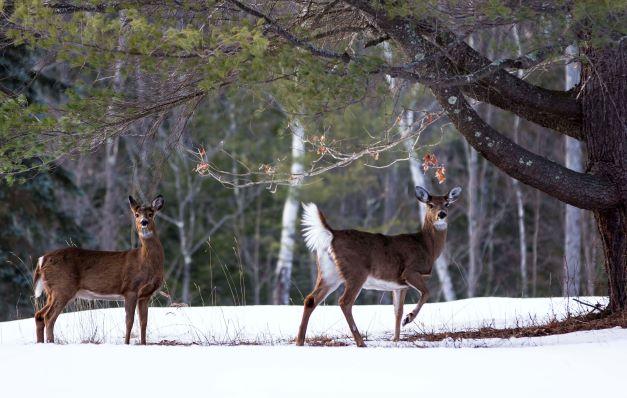- Tags:
- Wildlife,
- Something Wild
Listen to this story on the NHPR website.
It seems like everyone in New Hampshire has at least a few good deer stories, and why not, since the statewide population of whitetail deer is estimated to be 100,000. That is at least one deer for every 13 people living in New Hampshire.
November is certainly the right month to talk about deer. It’s the peak of breeding season, as female does come into estrus and the male bucks are most active during the annual rut.
It’s interesting to see the takeaways from an extensive Deer-Forest study coordinated by wildlife biologists from Penn State. The study, which began in 2013 and continues through 2026, is surveying over 1,000 deer in Pennsylvania, using radio collars to track deer movements over the long-term.
New Hampshire deer are close to the northern limit of their natural range in the east, so they have slightly different challenges compared to those in Pennsylvania. "But the study has given us a lot of insight into what deer do when they melt back into the forest," says Chris Martin, Something Wild co-host.
In the Granite State, deer rely heavily on acorns, beech, and hazelnuts. You’ll often find deer on field edges and in brushy habitats in the Connecticut River valley, and on the edges of woods in suburbs across southern New Hampshire.

It might seem counterintuitive to find more deer in less-forested areas nearer people, but the agricultural land and suburbs have proportionately more food, more sunlight and more of the edge and brush habitats that deer favor.
"The deep, dense, dark woods of northern N.H. have no understory vegetation and thus are not as delicious to deer as former farms,” says Dave Anderson, Something Wild co-host.
The study reveals that while deer generally stick to a home range of about one square mile, individuals sometimes go “walkabout” for several miles. Both does and bucks may decide to take off for as long as 20 hours, and later return to their normal home range. No one is quite sure why.
In June, when ready to give birth, a pregnant doe will try to find a safe spot, and will return to that same site to give birth each year. Ironically, they might select a location near a road, despite what seems like an obvious risk, to serve as a kind of protection from one of their main predators – humans.
A doe will often leave a fawn right where they are born, only returning to nurse them. They seem to be aware that the more often they visit their fawn, the more danger that poses.
Deer are considered to be crepuscular, or most active during dawn and dusk. But the deer in this study didn’t start moving until around 10 a.m. The peak movement for bucks was around noon.
Deer feed, and then seek shelter midday where they ruminate. Whitetail deer have four chambered stomachs. When deer feed, they tongue food to the back of their mouths and chew just enough to swallow. After a deer fills its gut, it lies down to chew its cud and re-swallow it.
Deer evolved as a prey species. Their eyes are located on the sides of their head, giving them a 310 degree field of view without moving their head. They perceive any movement effectively in slow-motion and react instantly.
Deer are acutely aware of activity in the forest, so much so that hunters are convinced deer “know” when hunting season has started. But deer are becoming habituated to suburban or ex-urban environments, considered more of an agricultural pest by gardeners.
The cynical among us might ask if we study them in order to better hunt them or to learn how to keep them out of the garden.
“Deer are amazing creatures,” says Anderson. “There are lots of reasons to know more about deer, and learning about deer allows us to learn more about forests.”
In New Hampshire, the high density of deer is impacting the overall regeneration of hardwoods, notably sugar maple and red maple, as well as many wildflowers in the forest understory.
Our winters are less severe; warmer and wetter. As a result there is increasingly better survival of wintering deer. The issue is really how many healthy deer can N.H. forests support?
Most people still love just seeing a deer, even as deer are becoming adapted to living alongside humans.
Check out the blog posts from the Penn State study researchers to see what they’ve discovered about deer and the deer-forest-soil relationship.
Something Wild is a joint production of NH Audubon, The Society for the Protection of NH Forests and NHPR.
